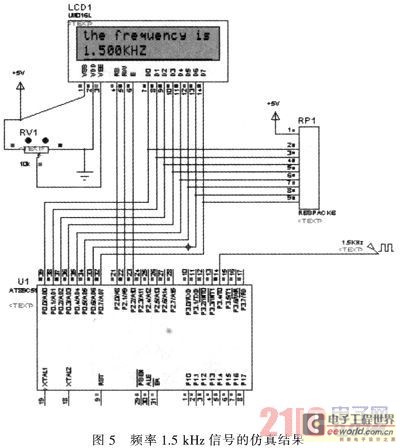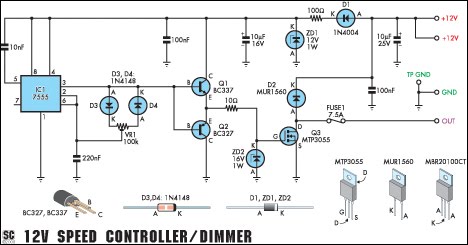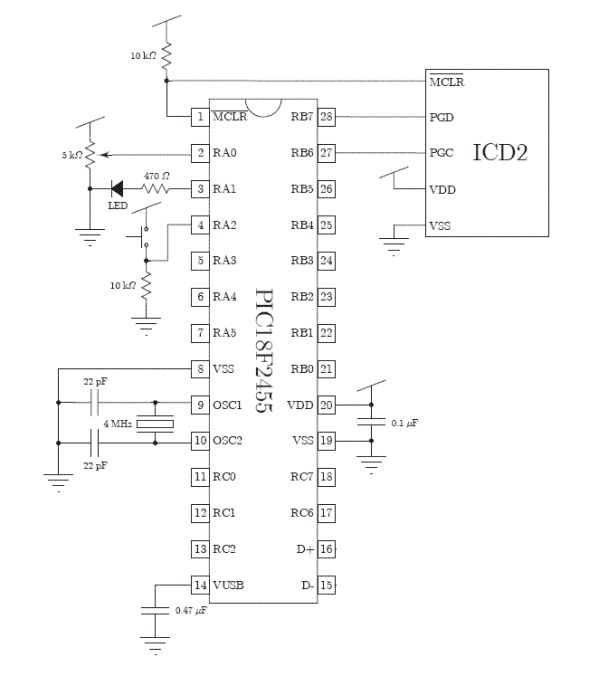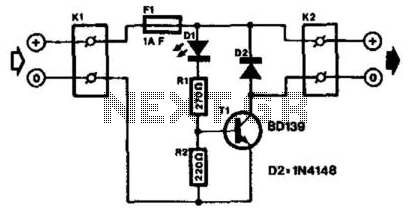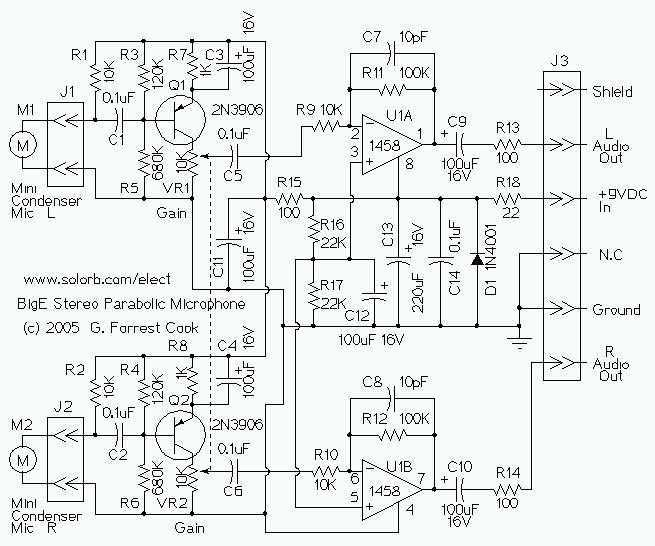
Remote control by mobile phone

Many individuals may have an old mobile phone that is no longer in use. The circuit presented in this article repurposes the old mobile, allowing it to control an electrical appliance in or around the home by switching it on and off. Additionally, the circuit can respond to predefined commands with spoken replies. The complexity of the circuit is significantly reduced by utilizing a PIC microcontroller. The inclusion of a speech synthesizer chip enables the control unit to provide spoken information to the user on the calling phone. The schematic for the Remote Control by Mobile Phone is illustrated in Figure 1. A headset connector is plugged into the mobile phone, with wires connecting to the earphone pieces linked to the input of a DTMF decoder IC type 8870 (IC1). The received signals are amplified by transistor T1 and then fed to pin RB2 of the central microcontroller, a PIC16F84 (IC2). DTMF, or dual-tone multi-frequency, is a tone coding/decoding system that has been utilized in wired telephone sets for nearly three decades. Each key on the DTMF keypad corresponds to a combination of two non-harmonically related tones within the audible range. At the receiving end, these tone pairs are decoded into their corresponding numbers (0-9, #, *). For this application, the mobile phone is set to auto-answer mode. During operation, the PIC microcontroller continuously monitors the level at RB7 (pin 13). A ring signal activates the PIC from its sleep state, prompting it to engage the speech chip (IC3), which relays a spoken message to the mobile phone via the microphone connector of the headset. Upon calling, the user hears a welcome message and is prompted to enter the system password (MSG1). The audio signal level can be adjusted using preset P2. The selection of spoken text stored in the speech chip is determined by the logic states of control lines A6, A7, and A8. The program running inside the PIC will await specific DTMF tones entered by the user on their phone (either mobile or landline). The received DTMF signals are decoded into corresponding numbers by IC1, which provides binary output information on outputs Q1-Q4, with output STD (pin 15) indicating the reception of a valid code to the PIC. Upon receiving a valid 4-digit password (which is compared to the one stored in the PIC's memory), the system will request a function code (MSG2). Depending on the response to MSG2, the microcontroller will toggle its RB5 control line logic Low or High. This signal activates a relay to switch an appropriately wired electrical appliance on or off (for instance, a coffee machine or central heating). The relay can be a solid-state device (allowing direct control from RB5) or a traditional solenoid-based switch controlled via a transistor buffer. The action performed at the receiving end is confirmed with a spoken message (MSG4 or MSG5). The speech chip also contains various other text messages (MSG3, MSG6, and MSG7) for handling unusual situations. The spoken messages are generated by an ISD25120 speech synthesizer, which has a storage capacity of about two minutes of speech. Different memory areas within the ISD25120 can be selected using address lines A0-A9, with the memory divided into eight segments of approximately 15 seconds, which can be individually addressed via A6, A7, and A8. This enables the PIC to select any specific spoken message and play it back by pulling the CE control input Low. Messages can be recorded and reviewed using a microphone and a small loudspeaker connected to IC3. Switches S4, S5, and S6 select the relevant memory area. The desired message is recorded on the chip via MIC1 while S2 is pressed, and the button should be released at the end of the message, which can be listened to by briefly pressing S1 (this requires switch S7 to be closed). If the recorded message is unsatisfactory, it can be re-recorded. During the recording and playback of messages, the PIC must be removed from its socket to manually set IC3's address lines. The provided Messages section offers examples of potential texts for voice feedback, along with the associated address settings. In applications like this, where equipment is controlled remotely, it is crucial to prevent unauthorized access. Therefore, password protection is necessary. The user can select a 4-digit password using the number keys on the mobile phone's keypad. To facilitate this, switch S3 must be opened (it is closed during standard operation). In this mode, the four digits entered on the calling phone after the welcome message will be accepted as the new password and subsequently stored in the PIC's RAM. If power outages are frequent, it is advisable to power the circuit with a battery system that includes mains charging to prevent password loss. Figure 2 illustrates the copper track layout and component mounting plan for the PCB designed for the remote control. It is recommended to use sockets for the ICs, as the PIC must be removed during the recording of spoken messages. The article has largely described the operation and practical use of the circuit; understanding the function of all switches and controls is essential for proper assembly and ease of operation. The source code for the PIC control program is available for free download from the website, as well as on floppy disk (order code 040415-11). Users without access to a suitable PIC programmer can purchase the PIC micro pre-programmed. The PCB artwork is shown at actual size in Figure 2. Once all components are installed (with ICs inserted in sockets), the controls can be connected via short lengths of stiff wire: S1, S2, S3, S4, S5, and S6, along with the electret microphone capsule and, if necessary, the loudspeaker (along with S7). The latter components are primarily for checking spoken messages, with switch S7 allowing the loudspeaker to be turned off during regular use. The mobile phone link can be connected to connector K1. The output relay for the electrical appliance to be controlled (from anywhere in the civilized world) is connected to the terminals adjacent to S3 on the board. The circuit operates with a supply voltage of 6-15 VDC from a mains adapter capable of providing approximately 100 mA. There is one adjustment in the circuit: preset P1 determines the input sensitivity of the DTMF IC, although this setting is not critical, and the circuit typically functions well with the wiper positioned at mid-travel. The mobile phone must support auto-answer mode, meaning it should be able to answer an incoming call on the first ring signal; some mobile phones may not display this option until a headset is connected. The ring signal must also be audible in the headset for proper operation.Many of you will have an old mobile phone gathering dust. The circuit shown in this article gives the old mobile a new lease of life, enabling it to switch an electrical appliance on and off in or around the home. The circuit will even talk to you on in reply to predefined commands. The overall complexity of the circuit is greatly reduced by the use of a PIC microcontroller. The addition of a speech synthesizer chip allows the control unit to return spoken information to the user on the calling phone. The schematic of the Remote Control by Mobile Phone is given in Figure 1. The connector for the headset is plugged into the mobile phone and the wires to the earphone pieces are connected to the input of a DTMF decoder IC type 8870 (IC1).
The received signals are amplified by T1 and then applied to pin RB2 of the central microcontroller, a PIC16F84 (IC2). DTMF stands for dual-tone multi-frequency, a tone coding/decoding system that`s been in use on wired telephone sets for almost 30 years now.
Each key on the DTMF keypad is linked to a combination of two (nonharmonically related) tones in the audible range. At the receiving side, the tone pairs are decoded into the matching number (0-9, #, *). For our application, the mobile phone is set to auto-answer mode. In operation, the PIC micro will continuously monitor the level at RB7 (pin 13). A ring signal will wake up the PIC from its sleep state and cause it to activate the speech chip (IC3) which supplies a spoken` message to the mobile phone via the microphone connector of the headset.
At the calling end, the user hears the welcome message and is prompted to enter the system password (MSG1). The level of the audio signal may be adjusted on preset P2. The selection of spoken text stored in the speech chip is determined by the logic state of control lines A6, A7 and A8.
Next, the program running inside the PIC will wait for certain DTMF tones entered by the user on his/her phone (mobile or landline). The received DTMF signals are decoded into the matching numbers by IC1, which supply binary output information on outputs Q1-Q4, with output STD (pin 15) flagging reception of a valid code to the PIC.
Having received a valid 4-digit password (which is being compared to the one stored in the PIC`s memory), the system will request a function code (MSG2). Depending on the information received in response to MSG2, the micro will pull its RB5 control line logic Low or High.
This signal enables a relay to switch a suitably wired up electrical appliance in your home to be switched on or off (for example, a coffee machine or the central heating). The relay may be a solid-state device (which allows direct control from RB5), or a traditional solenoid-based switcher that`s controlled via a transistor buffer.
The action executed at the receiving side is confirmed with a spoken message (MSG4 or MSG5). The speech chip contains yet other text messages (MSG3, MSG6 and MSG7) for the processing of situations out of the ordinary`. The spoken messages are supplied by a type ISD25120 speech synthesiser which has storage capacity for about two minutes worth of speech.
Different memory areas inside the ISD25120 may be selected using address lines A0-A9. Here, the memory has been divided into eight chunks of about 15 seconds that can be individually addressed over A6, A7 and A8. This allows the PIC to select any individual spoken messages and have it played back by pulling the CE control input Low.
The spoken messages may be recorded and checked using a microphone and a small loudspeaker connected to IC3. Switches S4, S5 and S6 select the relevant memory area. The relevant message is then recorded on the chip via MIC1 while S2 is pressed. The pushbutton should be released at the end of your message, which can be listened to by briefly pressing S1 (this requires switch S7 to be closed).
If you are not satisfied with the result, the text may be re-recorded. During recording ad playing back the messages (for checking) the PIC has to be removed from its socket, else IC3`s address lines cannot be set manually. The inset Messages` gives examples of texts you could use for the voice feedback, including the associated address settings.
In an application like this, where equipment is controlled from a remote location, it is essential to prevent unauthorised access. In any case, password protection is required. You, the user, may pick your own 4-digit password using the number keys on your mobile phone`s keypad.
For this to work you have to open switch S3 (which is closed during normal use). In that case, the four numbers entered on the calling phone after the welcome message has finished will be accepted as the new password, and subsequently stored in the PIC`s RAM memory. If mains outages are common in your home, we recommend powering the circuit from a battery system with mains charging, else the password will be lost.
Figure 2. Copper track layout and component mounting plan of the PCB designed for the remote control. Be sure to use sockets for the ICs, as the PIC has to be removed during recording of the spoken messages. The above article text having largely described the operation and practical use of the circuit, you should know the function of all switches and other controls and use this information to fit the relevant parts on the case in such a way that the unit is easy to operate in practice.
The source code of the PIC control program written by the author is available as a free download from our website, as well as on floppy disk (order code 040415-11). Those without access to a suitable PIC programmer may also buy the PIC micro ready-programmed as The PCB artwork is shown at true size in Figure 2.
With all components fitted (insert the ICs in sockets) the controls may be connected up via short lengths of stiff wire: S1, S2, S3, S4, S5 and S6, the electret microphone capsule and (if required) the loudspeaker (together with S7). The latter parts are mainly needed to check the spoken messages, switch S7 allowing the loudspeaker to be switched off during normal use.
Next, the mobile phone link may be hooked up on connector K1. The output relay for the electrical appliance you wish to control (literally from anywhere in the civilised world!) is connected to the terminals beside S3 on the board. The circuit is happy with a 6-15 VDC supply voltage from a mains adaptor capable of supplying 100 mA or so.
There is only one adjustment in the circuit: preset P1 determines the input sensitivity of the DTMF IC. The setting is not critical however and the circuit will usually work with the wiper at mid travel. 3. The mobile has to support auto-answer mode`, that is, it has to be able to answer an incoming call on the first ring signal.
Some mobiles will not show this option until a headset is actually connected. 4. The ring signal has to be audible in the headset, too, as it its something into the calling phone. 🔗 External reference
The received signals are amplified by T1 and then applied to pin RB2 of the central microcontroller, a PIC16F84 (IC2). DTMF stands for dual-tone multi-frequency, a tone coding/decoding system that`s been in use on wired telephone sets for almost 30 years now.
Each key on the DTMF keypad is linked to a combination of two (nonharmonically related) tones in the audible range. At the receiving side, the tone pairs are decoded into the matching number (0-9, #, *). For our application, the mobile phone is set to auto-answer mode. In operation, the PIC micro will continuously monitor the level at RB7 (pin 13). A ring signal will wake up the PIC from its sleep state and cause it to activate the speech chip (IC3) which supplies a spoken` message to the mobile phone via the microphone connector of the headset.
At the calling end, the user hears the welcome message and is prompted to enter the system password (MSG1). The level of the audio signal may be adjusted on preset P2. The selection of spoken text stored in the speech chip is determined by the logic state of control lines A6, A7 and A8.
Next, the program running inside the PIC will wait for certain DTMF tones entered by the user on his/her phone (mobile or landline). The received DTMF signals are decoded into the matching numbers by IC1, which supply binary output information on outputs Q1-Q4, with output STD (pin 15) flagging reception of a valid code to the PIC.
Having received a valid 4-digit password (which is being compared to the one stored in the PIC`s memory), the system will request a function code (MSG2). Depending on the information received in response to MSG2, the micro will pull its RB5 control line logic Low or High.
This signal enables a relay to switch a suitably wired up electrical appliance in your home to be switched on or off (for example, a coffee machine or the central heating). The relay may be a solid-state device (which allows direct control from RB5), or a traditional solenoid-based switcher that`s controlled via a transistor buffer.
The action executed at the receiving side is confirmed with a spoken message (MSG4 or MSG5). The speech chip contains yet other text messages (MSG3, MSG6 and MSG7) for the processing of situations out of the ordinary`. The spoken messages are supplied by a type ISD25120 speech synthesiser which has storage capacity for about two minutes worth of speech.
Different memory areas inside the ISD25120 may be selected using address lines A0-A9. Here, the memory has been divided into eight chunks of about 15 seconds that can be individually addressed over A6, A7 and A8. This allows the PIC to select any individual spoken messages and have it played back by pulling the CE control input Low.
The spoken messages may be recorded and checked using a microphone and a small loudspeaker connected to IC3. Switches S4, S5 and S6 select the relevant memory area. The relevant message is then recorded on the chip via MIC1 while S2 is pressed. The pushbutton should be released at the end of your message, which can be listened to by briefly pressing S1 (this requires switch S7 to be closed).
If you are not satisfied with the result, the text may be re-recorded. During recording ad playing back the messages (for checking) the PIC has to be removed from its socket, else IC3`s address lines cannot be set manually. The inset Messages` gives examples of texts you could use for the voice feedback, including the associated address settings.
In an application like this, where equipment is controlled from a remote location, it is essential to prevent unauthorised access. In any case, password protection is required. You, the user, may pick your own 4-digit password using the number keys on your mobile phone`s keypad.
For this to work you have to open switch S3 (which is closed during normal use). In that case, the four numbers entered on the calling phone after the welcome message has finished will be accepted as the new password, and subsequently stored in the PIC`s RAM memory. If mains outages are common in your home, we recommend powering the circuit from a battery system with mains charging, else the password will be lost.
Figure 2. Copper track layout and component mounting plan of the PCB designed for the remote control. Be sure to use sockets for the ICs, as the PIC has to be removed during recording of the spoken messages. The above article text having largely described the operation and practical use of the circuit, you should know the function of all switches and other controls and use this information to fit the relevant parts on the case in such a way that the unit is easy to operate in practice.
The source code of the PIC control program written by the author is available as a free download from our website, as well as on floppy disk (order code 040415-11). Those without access to a suitable PIC programmer may also buy the PIC micro ready-programmed as The PCB artwork is shown at true size in Figure 2.
With all components fitted (insert the ICs in sockets) the controls may be connected up via short lengths of stiff wire: S1, S2, S3, S4, S5 and S6, the electret microphone capsule and (if required) the loudspeaker (together with S7). The latter parts are mainly needed to check the spoken messages, switch S7 allowing the loudspeaker to be switched off during normal use.
Next, the mobile phone link may be hooked up on connector K1. The output relay for the electrical appliance you wish to control (literally from anywhere in the civilised world!) is connected to the terminals beside S3 on the board. The circuit is happy with a 6-15 VDC supply voltage from a mains adaptor capable of supplying 100 mA or so.
There is only one adjustment in the circuit: preset P1 determines the input sensitivity of the DTMF IC. The setting is not critical however and the circuit will usually work with the wiper at mid travel. 3. The mobile has to support auto-answer mode`, that is, it has to be able to answer an incoming call on the first ring signal.
Some mobiles will not show this option until a headset is actually connected. 4. The ring signal has to be audible in the headset, too, as it its something into the calling phone. 🔗 External reference
